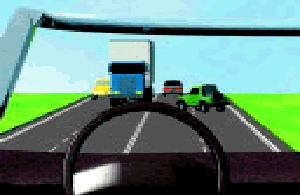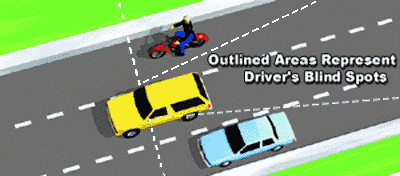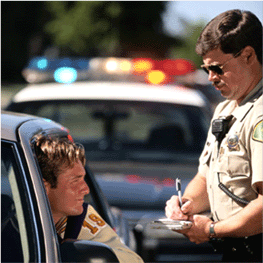Cal-Driver-Ed.Com |
|
California's Home Study Driver Education Class |
To easily find this site again, hit Ctrl+D, or drag this link: Cal-Driver-Ed to your Favorites.
| Log-In | Driver Education | Driver Training | DMV Requirements | FAQs | Compare | Contact Us |
|
The California DMV Driver Handbook |
To avoid last minute moves, you should look down the road 10 to 15 seconds ahead of your vehicle. A driver needs to look that far ahead to see hazards early. Constantly staring at the road just in front of your car is dangerous. If you look far enough ahead, you will be able to see important things such as someone getting into a parked car. In the city, you should look at least one block ahead which is about 10 to 15 seconds. On the highway, 10 to 15 seconds is about a quarter of a mile.
Take In the Whole Scene: Looking 10 to 15 seconds ahead does not mean looking only at the middle of the road. It means looking at the side of the road as well. Looking from side to side helps you to see:
Keep your eyes moving (scanning). Look near and far. Turn your head before changing lanes, because mirrors have blind spots. These blind spots can hide a motorcycle or bicycle. Watch for things about to happen like a ball rolling into the street; a car door opening; a swerving bicycle. Watch for Hazards: Look beyond the car ahead of you. Don’t develop a “fixed stare.” Look around. Keep your eyes moving. Check your rear view mirrors frequently (every 2 to 5 seconds) so that you know the position of vehicles near you. On the freeway, be ready for changes in traffic conditions. Watch for signals from other drivers. Expect merging vehicles at onramps and interchanges. Be prepared for rapid changes in road conditions and traffic flow. As you look ahead, think about what will (or might) happen on the road. Be alert for vehicles on either side, to the front, and to the rear. Use your mirrors. Leave enough space between you and the vehicle ahead for safe stops. Always leave yourself an “out.” Mistakes cause accidents. To protect yourself, know which lanes are clear so you can use them if you need to. Any time you come to a place where people may cross or enter your path, you should look to the sides to make sure no one is coming. Always look to the sides at intersections, crosswalks, and railroad crossings. An intersection is any place where one line of traffic meets another. It includes: Follow these rules at intersections:
Crosswalks: Every intersection where streets with sidewalks meet “at about right angles” has a crosswalk for pedestrians even though there may be no painted lines. The crosswalk is that part of the pavement where the sidewalk lines would extend across the street and are areas set aside for people to cross the street. They are often marked with white lines. Yellow crosswalk lines may be painted at school crossings. Some crosswalks, especially in residential areas, are not marked. Some crosswalks have flashing lights to warn you that pedestrians may be crossing. Whether or not the lights are flashing, you must look for pedestrians and be prepared to stop. Most crosswalks are at corners. Sometimes they are in the middle of the block. Before turning a corner, watch for people who are about to cross the street. Remember, if you have a green light, the light is also green for them. Pedestrians have the right-of-way in crosswalks. If you stop in the crosswalk, you are violating their right-of-way and placing them in danger. Roadside Areas: Whenever there is activity along the side of the road, there is a good chance someone will cross or enter the road. It is very important to look to the sides of the road when you are near:
It is a good idea to check traffic behind you often. You will know if cars are tailgating (following you too closely), coming up behind you too fast, or if you have time to get out of the way before a driver hits your vehicle from the rear. It is very important to check behind you before you change lanes, slow down quickly, back up, or drive down a long or steep hill. Whenever you change lanes, check behind you to make sure you are not getting in the way of cars in that lane. Changing lanes includes:
Before changing lanes, signal and always check traffic behind and beside you by:
When you must slow down suddenly, take a quick glance in your mirrors. You should also check your mirrors when you are preparing to turn into a side road or driveway, and when you are stopping to pull into a parking space. Backing up is always dangerous because it is hard to see what is behind your vehicle. Whenever you need to back up or back out of a parking space, follow these rules:
On long steep downgrades, keep a look out for large vehicles which can gather speed very quickly. Having Clear Windows And Mirrors Keep your windshield and side windows clean inside and out. Bright sun or headlights on a dirty window make it hard to see out. You should clear ice, frost, or dew from all windows and outside mirrors before you drive. It is illegal to block your view of the road by putting signs or other objects on the front windshield. Don’t hang things on the mirror. Don’t block your view through the back or side windows with objects or signs. Tinted safety glass is allowed in permitted locations. Motorists with sun-sensitive skin can use removable sun screens on their vehicle’s side windows during daylight travel if they have a letter from their physician. Windshield stickers, etc., are permitted only in four places:
Make sure you can see and be seen. If you drive in rain or snow, you may have to stop sometimes to wipe mud or snow off your windshield, headlights, and taillights. Adjusting Your Seat And Mirrors Always adjust the seat, mirrors, and safety belt before starting your vehicle. You may have an accident if you try to adjust them while driving. (More info) Adjust your seat so that you are high enough to see the road. If you still can’t see, use a seat cushion. Do this before putting on your safety belt. Adjust your rear and side mirrors before you start driving. If your vehicle has a day/night mirror, learn how to use it. The night setting reduces the headlight glare from the cars behind you and helps you see better. Wearing Glasses Or Contact Lenses Follow your eye doctor's advice about glasses or corrective contact lenses. If your eye doctor tells you to wear them for driving, do it. If your license says you must wear "corrective lenses," wear them. You may be fined if you drive without wearing them. Never wear dark glasses or sunglasses at night. Consult your eye doctor before wearing tinted contact lenses at night. Don’t wear eyeglasses with temples wide enough to keep you from seeing clearly to the sides. How Well Can You See And Stop? If something is in your path, you need to see it in time to be able to stop. Assuming you have good tires, good brakes, and dry pavement:
Adjust your driving to the weather and road conditions (basic speed law). Turn on your lights during the day if it is hard to see. Don’t drive with only your parking lights on. Fog: The best advice for driving in the fog is DON’T. You should consider postponing your trip until the fog clears. However, if you must drive, then slow down and turn on your low beam headlights. The light from high beams will reflect back and cause glare. Never drive with just your parking or fog lights. Increase your following distance and be prepared to stop within the space you can see in front of your vehicle. Avoid crossing or passing lanes of traffic unless absolutely necessary. Listen for traffic you cannot see. Use your wipers and defroster as necessary for best vision. If the fog becomes so thick that you can barely see, pull completely off the road. Do not continue driving until you can see better. Turn off your lights or someone may see your taillights and drive into you. DARKNESS: Drive more slowly at night because you cannot see as far. Motorcycles are harder to see at night because most have only one taillight. You will have less time to stop if there is a hazard ahead. Make sure you can stop within the distance lighted by your headlights. More highway construction takes place at night. Reduce your speed. You must turn your headlights on 30 minutes after sunset and leave them on until 30 minutes before sunrise. Also, turn your lights on any time you can’t see at least 1000 feet ahead. Use your low beam headlights whenever it is raining. Don’t drive with only your parking lights on. Do not blind other drivers with your high beam headlights. Dim your lights to low beams within 500 feet of a vehicle coming toward you. If you are following another vehicle, change to low beams within 300 feet. Use your high beams whenever possible as long as it is not illegal (i.e., in open country or on dark city streets). When leaving a brightly lit place, drive slowly until your eyes adjust to the darkness. Don’t look directly into oncoming headlights. Look toward the right edge of your lane. Watch the oncoming car out of the corner of your eye. Do not try to “get back” at the other driver by keeping your bright lights on. If you do, both of you may be blinded. Drive as far to the right as possible if a vehicle with one light comes toward you. It could be a bicycle or motorcycle, but it could also be a vehicle with a missing headlight. In a very heavy rain or snowstorm, you may not be able to see more than 100 feet ahead. When you can’t see any farther than that, you cannot safely drive faster than 30 mph. You may have to stop from time to time to wipe mud or snow off your windshield, headlights, and taillights. Slow down at the first sign of rain, drizzle, or snow on the road. This is when many road pavements are most slippery because oil and dust have not been washed away. If you drive in snowy areas, carry chains in case you find yourself in conditions where you can’t drive without them. Make sure you carry the correct number of chains and that they will fit your drive wheels. Learn how to put the chains on before you need to use them. Hills and Curves: You never know what is on the other side of a steep hill or a sharp curve. When you come to a hill or curve, slow down so you can stop if a vehicle is stalled. You must be going slowly enough to stop. |
26 27 28 29 30 31 32 33 34 35 36 37 38 39 40 41 42 43 44 45 46 47 48 49 50 Glossary
|
Our Driver Education Course is Accepted by the California DMV View Our California DMV Verification Letter Sample DMV Driver Education Certificate of Completion  "Cal-Driver-Ed is a pioneer in the field of online driver education. Over 80,000 California teenagers have taken their courses and are driving today." "I recommend Cal-Driver-Ed for home study driver education." The following quotes are excerpts from a California DMV Study on the Effectiveness of Home-Study Driver Education (PDF) dated April 2003: "Home-study students performed just as well or better than classroom students ... " "Home-study courses may also have the additional benefit of increasing parental involvement in their teen's learning process, which has been shown to be an important factor ..." |
|
Cal Driver Ed is proud
|
|
Already Have Your License? Traffic school will help keep your auto insurance costs lower if you receive a traffic ticket. Every licensed California Driver must have auto insurance to drive a vehicle in California. Proof of insurance must be provided to the California DMV when you obtain your drivers license (not your learners permit). Proof of auto insurance must also be provided to DMV when you register or renew the license on a vehicle you own. |




